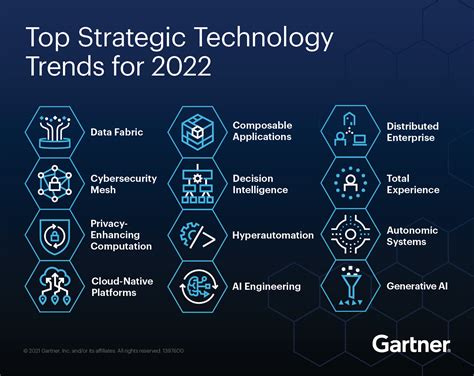Top 10 Technology Trends to Watch in 2022

Stay updated with the latest advancements in Artificial Intelligence, Quantum Computing, 5G, IoT, Cybersecurity, AR, Robotics, Green Tech, Blockchain, and Edge Computing. Learn about the future of technology!With the rapid pace of technological advancement, it’s essential to stay ahead of the curve on the latest trends. As we move into 2022, the tech industry continues to evolve, with new innovations and breakthroughs shaping the way we live and work. In this blog post, we’ll explore the top 10 technology trends to watch in 2022. From artificial intelligence and quantum computing to 5G networks and cybersecurity developments, these trends are set to make a significant impact in the coming year. We’ll delve into the advancements in Internet of Things, augmented reality, robotics and automation, as well as the rise of green technology solutions. Furthermore, we’ll examine the integration of blockchain in industries and the evolution of edge computing. Join us as we take a closer look at the exciting developments that are set to redefine the tech landscape in 2022.
Artificial Intelligence Innovations
Artificial intelligence (AI) has been making significant strides in recent years, with applications spanning across various industries. From healthcare to finance to entertainment, AI innovations are revolutionizing the way we live and work. One of the key areas where AI is making a substantial impact is in the development of autonomous vehicles. Companies like Tesla and Waymo are leading the charge in creating self-driving cars that rely on cutting-edge AI algorithms to navigate roads and make real-time decisions.
Another area of AI innovation is in the realm of chatbots and virtual assistants. As natural language processing technology continues to advance, chatbots are becoming more sophisticated and capable of handling complex queries and tasks. Virtual assistants like Siri, Alexa, and Google Assistant are increasingly integrated into our daily lives, providing us with personalized recommendations and information at our fingertips.
Moreover, AI is also being utilized to enhance cybersecurity measures, with predictive analytics and machine learning algorithms being used to detect and mitigate potential threats. This has become increasingly important as the digital landscape becomes more complex and interconnected, requiring advanced AI solutions to safeguard sensitive data and infrastructure.
Quantum Computing Breakthroughs
Quantum computing has been a topic of interest and research for many years, and in 2022, we are seeing some significant breakthroughs in this field. One of the most exciting developments is the progress towards achieving quantum supremacy, which refers to the point at which quantum computers can outperform classical computers in certain tasks. This milestone has the potential to revolutionize industries such as cryptography, drug discovery, and materials science.
Another key advancement in quantum computing is the increase in the number of qubits that can be controlled and manipulated. As more qubits are added to quantum processors, the computational power and capabilities of these machines grow exponentially. Researchers and companies are working tirelessly to overcome the technical challenges of scaling up quantum systems, and we are now on the cusp of witnessing quantum computers with hundreds or even thousands of qubits.
Furthermore, there have been breakthroughs in the development of error correction techniques for quantum computers. Errors are inherent in quantum systems due to their sensitivity to environmental disturbances, and finding ways to mitigate and correct these errors is crucial for the practical implementation of quantum algorithms. With the advancements in error correction, quantum computing is inching closer to becoming a reliable and robust technology that can handle complex real-world problems.
5G Network Expansion
5G network expansion is one of the most exciting technology trends to watch in 2022. With the rollout of 5G networks gaining momentum around the world, we can expect to see significant improvements in connectivity, speed, and capacity. This next-generation network technology has the potential to revolutionize the way we communicate, work, and interact with the world around us.
The 5G network expansion will not only benefit individual users but also businesses and industries. The increased speed and reliability of 5G networks will enable new and innovative applications in areas such as autonomous vehicles, remote healthcare, and smart cities. Furthermore, the higher bandwidth and lower latency of 5G will open up new possibilities for virtual and augmented reality experiences, as well as the Internet of Things (IoT) devices.
As 5G continues to expand, we can also expect to see improvements in network infrastructure and coverage. This will bring high-speed connectivity to more remote and underserved areas, bridging the digital divide and creating new opportunities for economic growth and development. With the potential for 5G to transform industries and society as a whole, its expansion in 2022 will undoubtedly be a key technology trend to keep an eye on.
Internet of Things Advancements
The internet of things (IoT) has been advancing rapidly in recent years, with the proliferation of smart devices and interconnected systems. One major advancement in IoT is the development of edge computing technology, which allows for data processing and analysis to occur closer to the source of the data, rather than relying solely on centralized servers. This has led to increased efficiency and reduced latency in IoT applications. Additionally, the integration of artificial intelligence and machine learning algorithms into IoT devices has enabled them to become more intelligent and autonomous, allowing for predictive maintenance, remote monitoring, and other advanced functionalities. Another significant advancement in IoT is the expansion of 5G networks, which provide the high-speed, low-latency connectivity needed to support the vast number of IoT devices being deployed. With these advancements, the potential for IoT to revolutionize industries such as healthcare, transportation, and manufacturing is greater than ever before.
Advancements in the area of IoT have also led to increased focus on cybersecurity, as the proliferation of connected devices has created new security vulnerabilities. This has driven the development of new security protocols and standards specifically tailored for IoT devices, as well as the adoption of blockchain technology to ensure the integrity and security of IoT data. Moreover, IoT advancements have also extended into the realm of environmental sustainability, with the development of green technology solutions aimed at reducing the energy consumption and environmental impact of IoT devices and systems. This includes the use of renewable energy sources, energy-efficient protocols, and lifecycle management strategies for IoT devices.
Furthermore, the integration of IoT advancements with augmented reality applications has opened up new possibilities for immersive and interactive experiences. IoT-enabled AR applications are being used in various industries, from retail and marketing to healthcare and education, to provide real-time data and insights in a visually compelling manner. As IoT continues to advance, the integration of robotics and automation progress is also becoming more prevalent. IoT devices are now being used to control and coordinate robotic systems in industrial and commercial settings, leading to greater precision, efficiency, and productivity.
Overall, the advancements in IoT technology are driving significant changes across various industries, as the proliferation of connected devices and the availability of real-time data are creating new opportunities for innovation and efficiency. With the continued evolution of IoT, we can expect to see even more impactful advancements in the coming years, as the potential for interconnected, intelligent systems continues to expand.
Cybersecurity Developments
In recent years, cybersecurity has become a critical concern for individuals, businesses, and governments alike. With the rise of digital transformation and increased connectivity, the need for robust cybersecurity measures has never been more urgent. In 2022, we can expect to see significant developments in the field of cybersecurity, as experts continue to innovate and adapt to evolving threats.
One of the key trends to watch in cybersecurity is the growing use of artificial intelligence and machine learning for threat detection and analysis. These technologies have the potential to enhance the speed and accuracy of cybersecurity efforts, enabling organizations to stay one step ahead of malicious actors.
Furthermore, the shift towards a more distributed workforce, as well as the increasing adoption of cloud computing, will drive the need for advanced cybersecurity solutions that can protect data and systems regardless of location. As such, we can anticipate new solutions and approaches to address the unique challenges posed by the changing nature of work and technology infrastructure.
Augmented Reality Applications
Augmented reality (AR) has been making significant strides in various industries, from gaming and entertainment to education and healthcare. The innovative technology blends the digital world with the physical environment, enhancing the user experience and providing new opportunities for engagement.
One of the most prominent applications of AR is in the field of education, where it allows students to interact with virtual models and simulations, making learning more interactive and immersive. In the healthcare sector, AR is being used for medical training and surgical procedures, offering a more precise and detailed view of the patient’s anatomy.
Moreover, AR is also being leveraged in the retail industry for virtual try-on experiences and product visualization, enabling customers to make more informed purchasing decisions. With the continuous advancement in AR technologies and the increasing accessibility of AR-enabled devices, the potential for its applications is only expected to grow in the coming years.
Robotics and Automation Progress
In the world of technology, robotics and automation have made significant progress in recent years. From industrial robots to autonomous vehicles, the use of robots and automation has been rapidly expanding across various industries. The advancements in artificial intelligence and machine learning have played a crucial role in improving the capabilities of robots, allowing them to perform complex tasks with greater efficiency and accuracy.
One of the key areas where robotics and automation have made progress is in the manufacturing sector. With the integration of advanced robotic systems, manufacturers are able to streamline their production processes, increase productivity, and reduce operational costs. This has not only improved the overall efficiency of manufacturing operations but has also led to the creation of new job opportunities in the field of robotics and automation.
Furthermore, the development of collaborative robots, also known as cobots, has revolutionized the way humans and machines interact in the workplace. These robots are designed to work alongside human workers, assisting them in various tasks and enhancing overall productivity. As a result, businesses are now able to achieve higher levels of flexibility and agility in their operations, ultimately leading to improved competitiveness in the global market.
Green Technology Solutions
Green technology solutions have become increasingly important in recent years as the world grapples with the effects of climate change and environmental degradation. From renewable energy sources to sustainable materials and waste reduction techniques, green technology is at the forefront of innovation in the tech industry. One of the most significant trends to watch in 2022 is the continued development and implementation of green technology solutions across various sectors.
Renewable energy, such as solar and wind power, is paving the way for a more sustainable future. Advancements in green technology have made these sources more efficient and cost-effective, leading to increased adoption by businesses and consumers alike. The shift towards cleaner energy is not only beneficial for the environment but also contributes to reducing reliance on fossil fuels and lowering carbon emissions.
Moreover, green technology extends beyond energy production to encompass sustainable practices in manufacturing, transportation, and construction. Innovations in eco-friendly materials, electric vehicles, and green building design are shaping the way we approach infrastructure and urban development. As we move into 2022, it’s clear that green technology solutions will play a pivotal role in addressing environmental concerns and promoting a more sustainable way of living.
Blockchain Integration in Industries
Blockchain technology has been making waves in the business world with its potential to revolutionize the way industries operate. The integration of blockchain in various sectors is set to bring about significant changes in the coming year. As we look ahead to 2022, it is important to keep an eye on the developments and innovations that blockchain technology will bring to different industries.
One of the key areas where blockchain integration is expected to have a major impact is in the supply chain management industry. The use of blockchain in supply chain management can provide greater transparency, traceability, and security across the entire supply chain network. This can help in reducing fraud, minimizing errors, and improving overall efficiency in the movement of goods.
Furthermore, blockchain technology is also poised to transform the financial sector by offering secure and efficient payment processes and reducing the need for intermediaries. The implementation of blockchain in financial services can lead to faster transactions, reduced costs, and enhanced security, thereby revolutionizing the way financial transactions are carried out.
Edge Computing Evolution
Edge computing is an emerging trend in the field of technology that is gaining momentum and transforming the way data is processed and delivered. This evolution in computing is driven by the increasing demand for real-time data processing and analysis, especially in the era of Internet of Things (IoT) devices and 5G networks. Edge computing involves processing data closer to the source, at the edge of the network, rather than relying on a centralized data center. This results in faster data processing, reduced latency, and improved efficiency.
The evolution of edge computing is paving the way for new innovations and applications across various industries, including healthcare, manufacturing, transportation, and more. As the adoption of IoT devices and 5G networks continues to grow, the need for efficient and reliable edge computing solutions becomes increasingly critical. This evolution is enabling advanced capabilities such as real-time analytics, AI-driven insights, and decentralized processing, leading to enhanced user experiences and operational efficiencies.
As edge computing continues to evolve, it is expected to play a key role in shaping the future of technology, enabling advanced applications such as autonomous vehicles, smart cities, and immersive AR/VR experiences. With the potential to revolutionize how data is processed and utilized, the evolution of edge computing is undoubtedly a trend to watch in 2022 and beyond.





